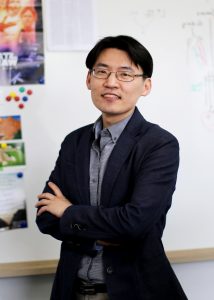Joongoo Kang, Ph. D.
Associate Professor/ PI
Room 308, E2
Department of Emerging Materials Science
Daegu Gyeongbuk Institute of Science and Technology (DGIST)
Daegu 42988, South Korea
Tel) +82-53-785-6517
E-mail) joongoo.kang@dgist.ac.kr
EDUCATION
Ph. D. in Physics, KAIST, Daejeon, Korea, 2007
M. S. in Physics, KAIST, Daejeon, Korea, 2003
B. S. in Physics, KAIST, Daejeon, Korea, 2001
WORK EXPERIENCE
Associate Professor, DGIST, Daegu, Korea, 2019 – present
Assistant Professor, DGIST, Daegu, Korea, Nov. 2014. – 2018
Staff Scientist IV, National Renewable Energy Laboratory (NREL), Golden, Colorado, U.S.A., 2014
Staff Scientist III, NREL, Golden, Colorado, U.S.A., 2010 – 2014
Postdoctoral research fellow, NREL, Golden, Colorado, U.S.A., 2008 – 2010
RESEARCH INTEREST
Research areas of interest include, but are not limited to: (i) materials design for energy conversion, storage, and transport, (ii) condensed matter theory of real materials, (iii) machine-learning aided materials theory, and (iv) materials physics of complex systems.
SELECTED PUBLICATIONS (*Corresponding author)
Materials physics for thermal energy storage
- J. Kang*, G. C. Glatzmaier, and S.-H. Wei, Origin of the bismuth-induced decohesion of nickel and copper grain boundaries. Phys. Rev. Lett. 111, 055502 (2013).
- J. Kang*, J. Zhu, C. Curtis, D. Blake, G. Glatzmaier, Y.-H. Kim, and S.-H. Wei, Atomically abrupt liquid-oxide interface stabilized by self-regulated interfacial defects: The case of Al/Al2O3 interfaces. Phys. Rev. Lett. 108, 226105 (2012).
- J. Kang*, J. Zhu, S.-H. Wei, E. Schwegler, and Y.-H. Kim, Persistent medium-range order and anomalous liquid properties of Al1-xCux alloys. Phys. Rev. Lett. 108, 115901 (2012).
- J. Kang*, S.-H. Wei, and Y.-H. Kim, Origin of the diverse melting behaviors of intermediate-size nanoclusters: Theoretical study of AlN (N = 51–58, 64). J. Am. Chem. Soc. 132, 18287 (2010).
- J. Kang and Y.-H. Kim, Half-solidity of tetrahedral-like Al55 clusters. ACS Nano 4, 1092 (2010).
- H. Xiang, J. Kang, S.-H. Wei, Y.-H. Kim, C. Curtis, and D. Blake, Shape control of Al nanoclusters by ligand size. J. Am. Chem. Soc. 131, 8522 (2009).
Two-dimensional nanomaterials
- J. Kang*, L. Zhang, and S.-H. Wei, A unified understanding of the thickness-dependent bandgap transition in hexagonal two-dimensional semiconductors. J. Phys. Chem. Lett. 7, 597-602 (2016).
- J. Kang* and S.-H. Wei, Tunable Anderson localization in hydrogenated graphene based on the electric field effect. Phys. Rev. Lett. 111, 216801 (2013).
- J. Kang, J. Bang, B. Ryu, and K. J. Chang, Effect of atomic-scale defects on the low-energy electronic structure of graphene: Perturbation theory and local-density-functional calculations. Phys. Rev. B 77, 115453 (2008).
- Y.-J. Kang, J. Kang, and K. J. Chang, Electronic structure of graphene and doping effect on SiO2. Phys. Rev. B 78, 115404 (2008).
Chemical physics for energy storage
- J. Kang*, Y. S. Jung, S.-H. Wei, and A. C. Dillon, Implications of the formation of small polarons in Li2O2 for Li-air batteries. Phys. Rev. B 85, 035210 (2012).
- J. Kang*, S.-H. Wei, K. Zhu, and Y.-H. Kim, First-principles theory of electrochemical capacitance of nanostructured materials: Dipole-assisted subsurface intercalation of lithium in pseudocapacitive TiO2 anatase nanosheets. J. Phys. Chem. C 115, 4909 (2011).
- Y.-H. Kim, J. Kang, and S.-H. Wei, Origin of enhanced dihydrogen-metal interaction in carboxylate bridged Cu2-paddle-wheel frameworks. Phys. Rev. Lett. 105, 236105 (2010).
- J. Kang, S.-H. Wei, and Y.-H. Kim, Microscopic theory of hysteretic hydrogen adsorption in nanoporous materials. J. Am. Chem. Soc. 132, 1510 (2010).
Microelectronics and photovoltaics
- J. Kang*, J.-S. Park, P. Stradins, and S.-H. Wei, Nonisovalent Si-III-V and Si-II-VI alloys: Covalent, ionic, and mixed phases. Phys. Rev. B 96, 045203 (2017).
- J.-S. Park, B. Huang, S.-H. Wei, J. Kang*, and W. E. McMahon, Period-doubling reconstructions of semiconductor partial dislocations. NPG Asia Mater. 7, e216 (2015).
- J.-H. Yang, J.-S. Park, J. Kang*, and S.-H. Wei, First-principles multiple-barrier diffusion theory: The case study of interstitial diffusion in CdTe. Phys. Rev. B 91, 075202 (2015).
- W.-J. Yin, J.-H. Yang, J. Kang, Y. Yan, and S.-H. Wei, Halide perovskite materials for solar cells: a theoretical review. J. Mater. Chem. A 3, 8926 (2014).
- J. Kang, Y.-H. Kim, J. Bang, and K. J. Chang, Direct and defect-assisted electron tunneling through ultrathin SiO2 layers from first principles. Phys. Rev. B 77, 195321 (2008).
- W.-J. Lee, J. Kang, and K. J. Chang, Defect properties and p-type doping efficiency in phosphorus-doped ZnO. Phys. Rev. B 73, 024117 (2006).
- J. Kang, E.-C. Lee, Y.-G. Jin, and K. J. Chang, H-related defect complexes in HfO2: A model for positive fixed charge defects. Appl. Phys. Lett. 84, 3894 (2004).
- J. Kang, E.-C. Lee, and K. J. Chang, First-principles study of the structural phase transformation of hafnia under pressure. Phys. Rev. B 68, 054106 (2003).